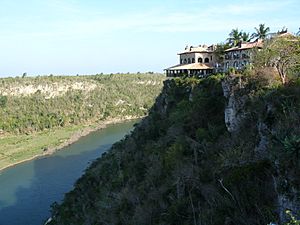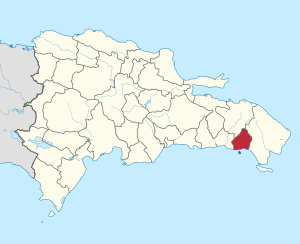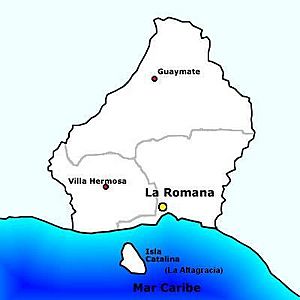La Romana Province, Dominican Republic facts for kids
Quick facts for kids
La Romana
|
||
|---|---|---|

La Romana, Dominican Republic landscape.
|
||
|
||

Location of the La Romana Province
|
||
| Country | ||
| Province since | 1944 | |
| Capital | La Romana | |
| Government | ||
| • Type | Subdivisions | |
| • Body | 3 municipalities 2 municipal districts |
|
| Area | ||
| • Total | 653.95 km2 (252.49 sq mi) | |
| Population
(2014)
|
||
| • Total | 344,580 | |
| • Density | 526.921/km2 (1,364.719/sq mi) | |
| Time zone | UTC-4 (EST) | |
| Area code | 1-809 1-829 1-849 | |
| ISO 3166-2 | DO-12 | |
| Postal Code | 22000 | |
La Romana is a province in the Dominican Republic. Its capital city is also called La Romana. This city is the third-largest in the country. La Romana became a province in 1944.
The province is home to Casa de Campo. This is one of the world's biggest resorts. It is also a top place for golf, with famous courses like Teeth of the Dog. Many artists from around the world perform at "Altos de Chavón". This is an artistic village and university.
La Romana is a port city. It is the Dominican Republic's seventh-largest city by population. About 130,000 people live there. The city is across from Catalina Island. It is about 80 kilometers (50 miles) from Santo Domingo. The name "La Romana" comes from a special scale. This scale was used to weigh goods for export. The city's patron saint is Santa Rosa de Lima.
Contents
History of La Romana Province
The province of La Romana was formed on January 1, 1961. It was created from a part of the older La Altagracia province. The city of La Romana became its capital.
The province has a simple political setup. It includes three main areas called municipalities. These are La Romana, Guaymate, and Villa Hermosa. Villa Hermosa became a municipality in 2004. There are also two smaller areas called municipal districts. These are Caleta and Cumayasa. La Romana is the most important municipality.
Where is La Romana Located?
La Romana province is in the eastern part of the Dominican Republic. To the north, it shares a border with El Seibo province. To the east, it borders La Altagracia province. The Caribbean Sea is to its south. To the west, it borders San Pedro de Macorís province.
It is one of the smallest provinces in the country. La Romana covers an area of 653.95 square kilometers. This is about 1.3% of the Dominican Republic's total land. The main rivers flowing through the province are Cumayasa, La Romana (also called Río Dulce), and Chavón.
Economy: How La Romana Makes Money
The economy of La Romana mainly relies on three things. These are the sugar industry, special economic zones (free zones), and tourism.
Sugar Production in La Romana
La Romana is known for its large sugar cane farms. You can still find places called bateyes here. Bateyes are small communities. They are built for workers who harvest sugar cane. These communities have houses and facilities for farm work.
Growing sugar cane is the main farming activity. Raising cattle for milk and meat is also important. The sugar industry is the biggest private employer in the country. It provides jobs for over 25,000 people.
Tourism and Free Zones
Tourism is very important for La Romana. Its beautiful beaches, hotels, restaurants, and shops attract many visitors. These tourist spots bring money to the province. They also create many jobs for local people.
The Central Romana company is a big business. It works in farming, tourism, and free zones. Free zones are special areas where companies can operate with fewer taxes. This company employs more than 25,000 people. Over half of the tourist buildings in La Romana were built by private companies. This has helped create even more jobs and grow the province. These buildings are made with strong materials. This ensures they are safe and last a long time.
Municipalities and Districts
The province of La Romana is divided into different areas. These areas help manage the province. As of June 20, 2006, it has three main municipalities. It also has two municipal districts.
- Guaymate
- La Romana
- La Caleta (Municipal District)
- Villa Hermosa
- Cumayasa (Municipal District)
See also
 In Spanish: Provincia de La Romana para niños
In Spanish: Provincia de La Romana para niños



